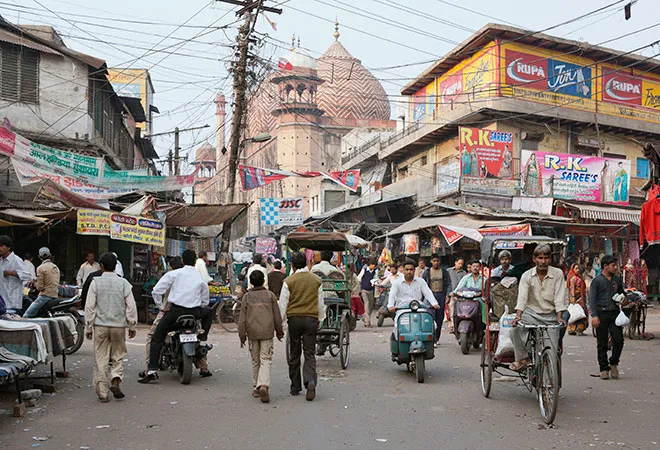
What do street lighting, CCTV cameras in public spaces, and jagged pieces of glass on top of boundary walls have in common? They are specific designs that attempt to moderate unwanted human behaviour. Street lighting is a physical signal that engenders a feeling of safety, creates space for citizens to traverse the area’s nightscape, and contributes to night-time economic development. CCTV cameras thwart anti-social behaviour from theft and violence to speeding and traffic violations; and glass on boundary walls keep away intruders. These forms of design have now transformed into plans for public spaces that aim to curb loitering, prevent crime and destruction of public property by designing ‘defensive infrastructure’ keeping public discomfort and inconvenience in mind. These plans include uncomfortable benches, spikes outside entries, and lack of sitting spaces in general. However, while infrastructural prompts may be important to keep public spaces safe and orderly, do they exclude vulnerable populations like the differently-abled, pregnant women, and the elderly from accessing it? Are these ‘defensive designs’ then, in fact, ‘hostile architecture’?
Developed cities like New York City (NYC) and London have these futuristic defensive plans across their burgeoning urban areas. Awkwardly spaced armrests on park benches, short backs on street furniture, and ‘leaning bars’ can be seen across New York, while London harbours designs like the ‘Camden Benches’, which are slightly slanted concrete benches, first installed in central London by the Camden Council in 2012. These designs control behavior by not allowing anyone to get too cosy, creating a more egalitarian use of space and time where no single individual can be allowed to lay claim on space for a prolonged period.
While these plans limit misuse of the object in question, as well as the area surrounding it, city planners need to ensure that they make public space accessible to all individuals. HDFC bank put up anti-homeless spikes in front of their branch in Mumbai's Fort area. The move sparked controversy and led the bank to remove them eventually. According to the US Department of Housing and Urban Development, NYC has nearly 80,000 homeless people living in wither shelters of the street. According to the 2011 census, there are 17.70 lakh homeless in India of which 57,416 stay in Mumbai. If urban planners and administrative officials want public spaces to be vagrant-free, it is essential for these large numbers to be provided appropriate rehabilitation in the form of shelters with adequate amenities and provisions.
Anti-vagrancy and anti-encroachment laws
The US has specific anti-vagrancy laws, which criminalise sleeping in public, sitting on sidewalks, and loitering. According to the National Law Center on Homelessness and Poverty, nearly half of US cities have laws which bar lying down or sitting in certain places. These are laws that have been made considering the high levels of development. In India, which is much lower in terms of human development indicators, the Union Ministry of Social Justice and Empowerment released the Persons in Destitution (Protection, Care and Rehabilitation) Bill, 2016. The proposed law decriminalises begging. The Delhi High Court also struck down the central provisions of the Bombay Prevention of Begging Act, 1959, as being arbitrary and violative of the right to life and liberty.
While India has not embarked deliberately on a defensive design campaign, the ‘encroachment resilience’ approach to several urban plans are testament to the fact that such designs might be incorporated in the near future. An “encroacher” is defined as anyone who occupies, obstructs, takes up cultivation or construction on private property or land declared to be the property of the government.
The 2034 Development Plan of Mumbai has extensive guidelines on how public amenity space should be demarcated and used, including details of road width and extensions, but no information on types of street furniture, which should be included. ‘Recreational Open Spaces’ in residential and commercial layouts are specified based on area of the zone, with stipulations about green space, and rules regarding how much open space can be used for public use structures/amenities. References to encroachment are made while detailing public streets and means of access, where “every site proposed to be developed or redeveloped shall have access from a public street/road and such access shall be kept free of encroachment.”
Street vendors, who sell their goods on the pavements or streets, or on push-carts on the streets, can be seen as encroachers as well. In India, 2.5 percent of a city’s population are street vendors. Assuming that the urban population now stands at around 430 million, there will currently be approximately 10 million hawkers. The Street Vendors (Protection of Livelihood and Regulation of Street Vending) Act, passed by Parliament in 2014, legalised the activity, where designated Temporary Vending Zones would be created in order for vendors to retain their livelihood.
Though an attempt has been made to account for the large number of informal vendors and the need to prevent their income generation avenues from being affected, vendors continue to face threats of eviction and harassment from local officials keen on creating the image of order and cleanliness in the urban sphere. They are often pressed by owners of residences and commercial establishments who do not want the streets in their vicinity to be cluttered with the presence of hawkers. Though the law has created space for inclusion, the implementation offers a different picture.
Access to public space must be ensured before attempts to moderate behavior
Defensive design, hostile architecture, and encroachment-resilient planning is usually targeted at the homeless and informal labourers, but it can negatively impact the elderly, pregnant women and the differently-abled. In developing cities, planners must first ensure access to public space is increased, before concepts of preventing access come into being. Urban local bodies should design for gender and differently-abled sensitive infrastructure, by looking into lighting, ramps, security cameras, reservations for female hawkers etc. more carefully. Public use amenities, such as toilets, must be constructed so that access to public space around it is achieved. Currently, Mumbai has around one lakh community and public toilet seats; but there is a 64 percent disparity between male and female seats in public toilets. These issues must be resolved in order to increase egalitarian use of public space, before an attempt to control the behaviour of individuals in a public space is made.
Defensive designing is “urban design intended to control, coerce and often prohibit interaction and social relations in public space.” These interactions contribute to density, which can be an important indicator of how safe someone feels in an environment. Eliminating it through design may be a deterrent to access. Public space should be a public good – while there has to be some discipline, regulation and control, this must not lead to reduced interaction, or exclusion. The ‘war on sitting’ against loiterers must not affect pedestrians, transit users, and vulnerable populations.
The views expressed above belong to the author(s). ORF research and analyses now available on Telegram! Click here to access our curated content — blogs, longforms and interviews.




 PREV
PREV


